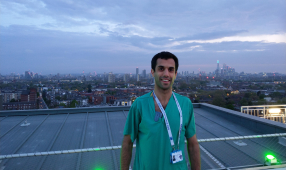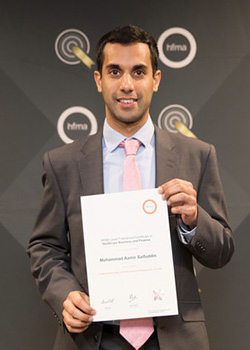Comment / COVID-19: reflections from the front line (part 2)
The Covid-19 pandemic became a major issue very quickly for NHS staff in March this year, leading to a stressful and busy period for those working on the frontline. In a two-part blog, gastroenterology and general medical registrar Aamir Saifuddin provides an insight into his experiences, how it has felt and what he has learnt.
Part 1 of Dr Saifuddin’s reflections can be found here
One of the major impacts of Covid-19 has been on how we are working together in the hospital. Despite the apprehension, while sitting in my Covid simulation session (one of dozens held for all staff at King’s College Hospital NHS Foundation Trust), the feeling of togetherness among the various participants was inspiring and highly motivating.
These are people who would never otherwise cross paths, including medical physicians, orthopaedic surgeons, dermatologists, fracture clinic nurses, physiotherapists, palliative care nurses – all of different grades.
It reminded me of that scene in Apollo 13 when the flight director overhears two NASA directors say: ‘This could be the worst disaster NASA has ever experienced.’ And he interjects with: ‘With all due respect, sir, I believe this is going to be our finest hour.’
This camaraderie has continued and my adult Covid ward has had dermatologists, paediatricians, HIV doctors, sexual health nurses, endoscopy nurses and others redeployed, all pulling together and sharing expertise within these randomly assigned teams to achieve the best for our patients.
No Covid frontline reflections would be complete without a mention of PPE, the range of personal protective equipment used by all staff to protect ourselves from the virus. Sometimes a distant interaction won’t require ‘full PPE’. But sometimes you might be performing chest physiotherapy or an endoscopy. Or you might be in an area, such as A&E or intensive care, with a high patient density, where the risk of exposure is very high and the highest level of protection is needed.
Tragically, many healthcare workers have died from Covid, many presumably having caught the virus from a patient, so this is a very emotive topic. A comment on government policy is outside the scope of this piece, but suffice to say that having a constant supply of PPE will be crucial for many months to come.
One of the initial difficulties was the changing guidance based on new evidence, especially when advice was ‘downgraded’. Some, understandably, have found it hard to decrease the amount of protection used when one’s own health is so palpably at stake. This can lead to staff wearing ‘inappropriate levels’ of PPE, which may affect stock levels. This, unfortunately, is the reality and somehow needs to be taken account of as workers are entitled to feel protected.
A side-effect of PPE I hadn’t considered is how difficult it is to communicate while wearing a mask. Overnight during a recent weekend, I led a cardiac arrest situation on a ward and it was tricky trying to effectively communicate with dozens of faceless colleagues.
Similarly, the subtle facial expressions you use when breaking bad news and that face-to-face connection where you can feed off these expressions is obliterated. Relatives are seldom allowed to visit any more. When they do, it’s because a patient is terminal, and explaining this while wearing a mask, particularly once the patient has died, seems very inadequate.
Most conversations we would normally have in-person, such as when a patient deteriorates, or when discussing resuscitation status, are now done by phone. Again, this makes it hard to gauge non-verbal cues to determine how to tactfully progress the conversation.
Finally, the pandemic will change how we practise medicine for months, maybe years to come. There have been rapid innovations that have been waiting to happen for a long time, such as telephone and video consultations, remote medical meetings and using apps so patients can regularly interact with their clinical teams. Along with more efficient working patterns and community initiatives these have helped to reduce hospital attendances. A silver lining is that development of this infrastructure has accelerated and this will give patients more flexibility to access medical care.
In such a short space of time, the whole world has changed. I feel both privileged and fortunate to be a doctor during this period. I’ve been able to directly help those in need and still go to work and see friends, teach and support junior colleagues. As ever, it’s been great to experience the well-known ‘banter’ within a hospital – which only increases at times of crisis! – and be part of this huge, incredible NHS family.
However, it remains personally scary, because we still only see the sickest patients, undiluted by the vast majority who have mild symptoms.
We’re in recovery mode now, trying to reinstate important services like urgent care for suspected cancer cases, while balancing the ongoing demand of COVID patients. We also need to ensure people with acute non-Covid illnesses aren’t deterred from attending A&E as they normally would.
I’ve seen many patients in extremis who would clearly normally have sought help earlier had they not been worried about catching the virus. And A&E attendances are significantly decreased compared to normal, despite hospitals being well-equipped to help.
There’s still so much to learn, not least the implications of infection on future immunity or the effects of relaxing lockdown measures. But the focus now is on minimising the harm to patients with non-Covid illnesses while being wary of a dreaded ‘second wave.’
Part 1 of Dr Saifuddin’s reflections can be found here
Dr Saifuddin is a recent graduate of the HFMA advanced qualifications programme in healthcare business and finance (pictured above)
Related content
The Institute’s annual costing conference provides the NHS with the latest developments and guidance in NHS costing.
The value masterclass shares examples of organisations and systems that have pursued a value-driven approach and the results they have achieved.